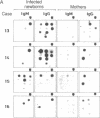Abstract
A panel of Trypanosoma cruzi antigens produced by recombinant DNA techniques was used to analyze the IgM and IgG specificities present in sera from 22 mothers with chronic Chagas disease and their newborn infants. Ten of the newborns were congenitally infected and the other 12 children were healthy. While in most cases IgG specificities in the newborns mirrored those of their mothers, congenitally infected newborns had, in addition, IgG specificities that were undetectable in their mothers. The new IgG specificities observed most frequently were against a shed acute-phase antigen (SAPA), and less frequently, against other nine different parasite antigens. Thus, SAPA is able to identify new fetal IgGs because antibodies against this antigen are generated during the acute phase of the infection and not in their chronically infected mothers. Sera from congenital cases also had IgMs against several parasite antigens, but again, SAPA was the most frequently detected. Neither IgMs nor new IgG specificities were detected in healthy children born to mothers with Chagas disease. We conclude that individual antigens can be used to detect new IgG specificities present in the cord blood from infected newborns. Furthermore, detection of IgMs and new fetal IgGs with recombinant antigens may be used to sort out congenitally infected infants from uninfected ones, a method that might be applied to other infectious diseases.
Full text
PDF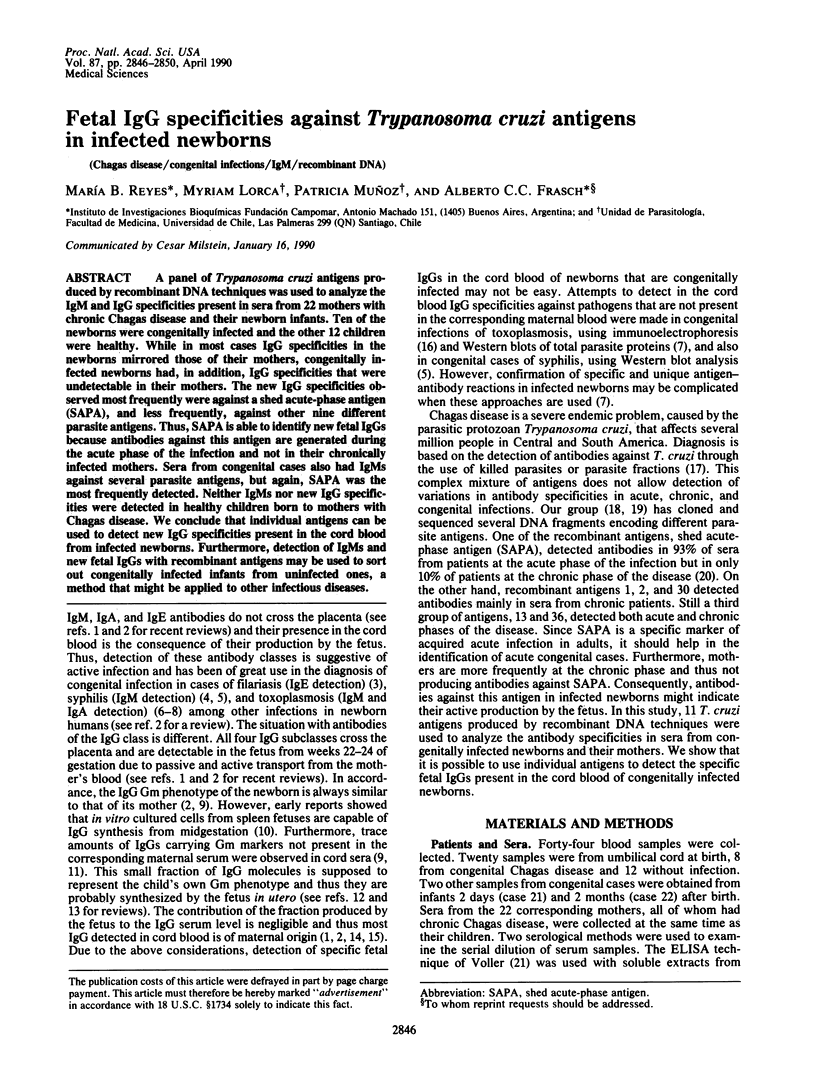
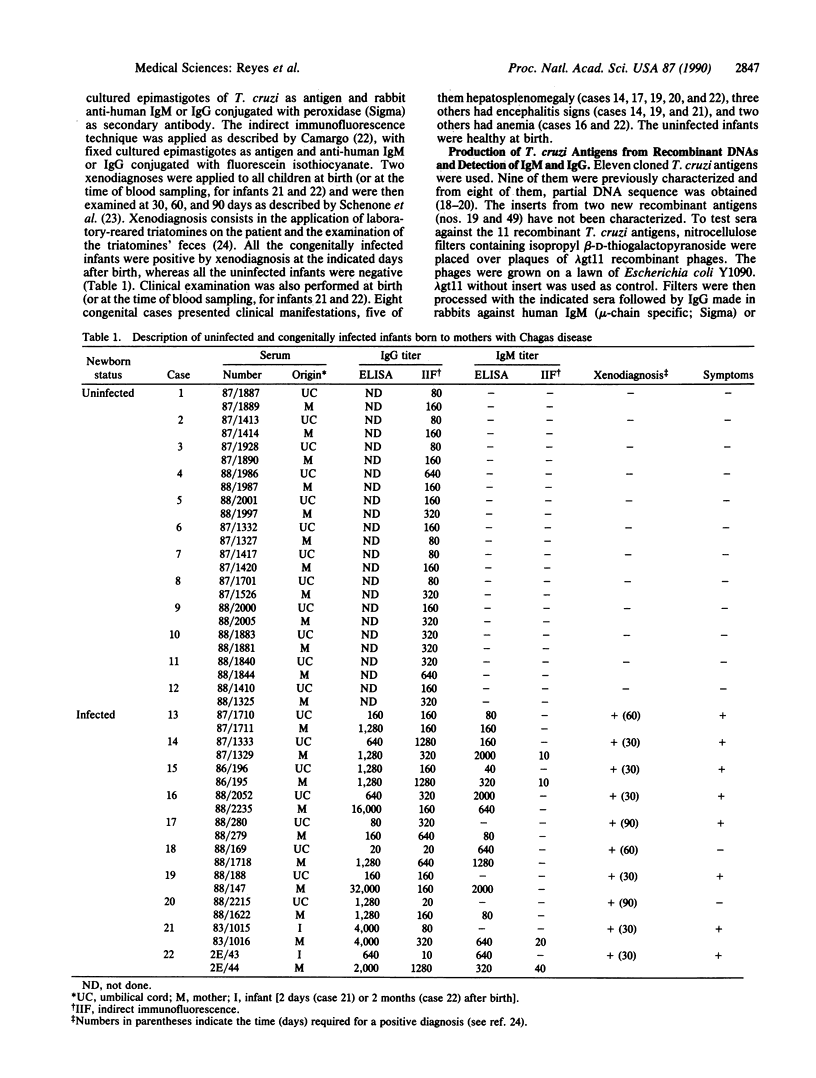
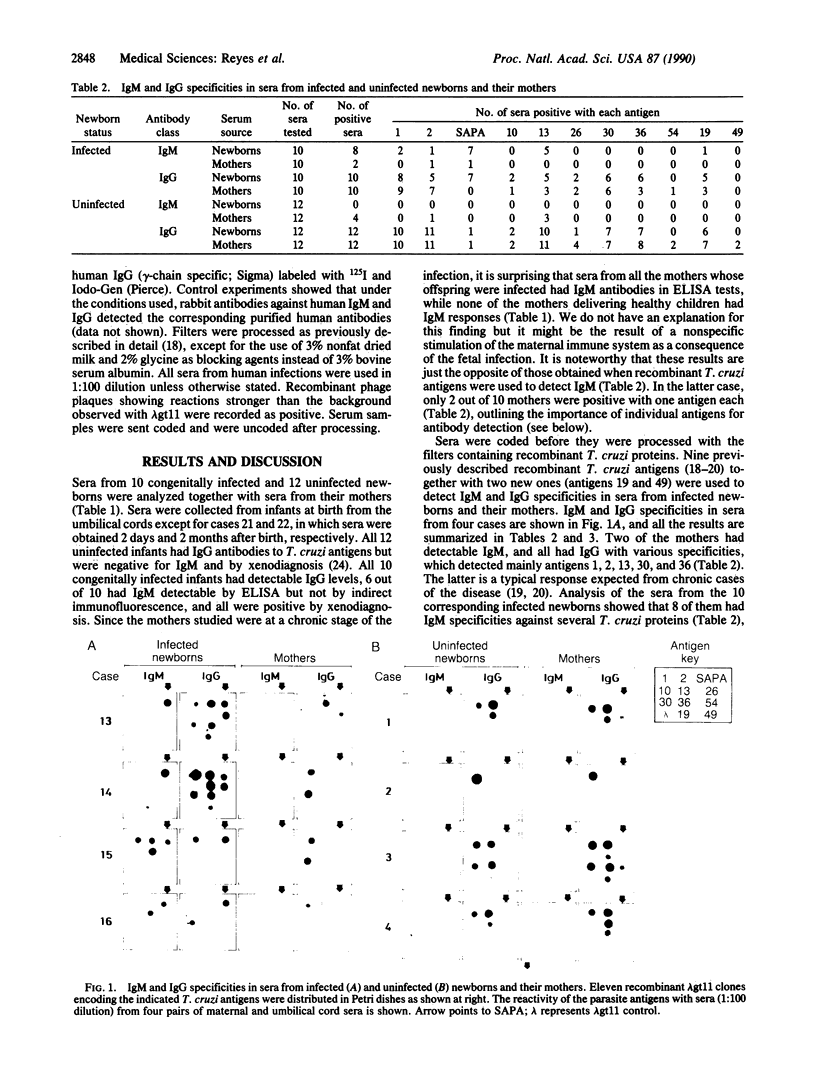
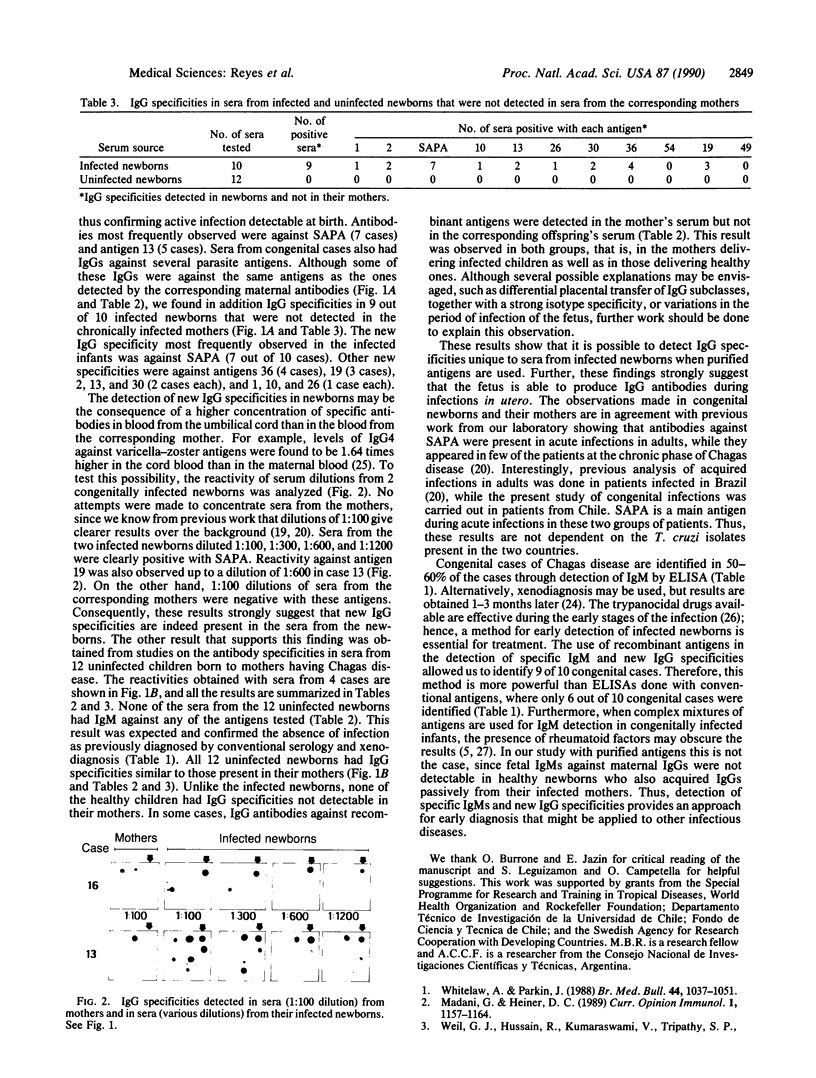
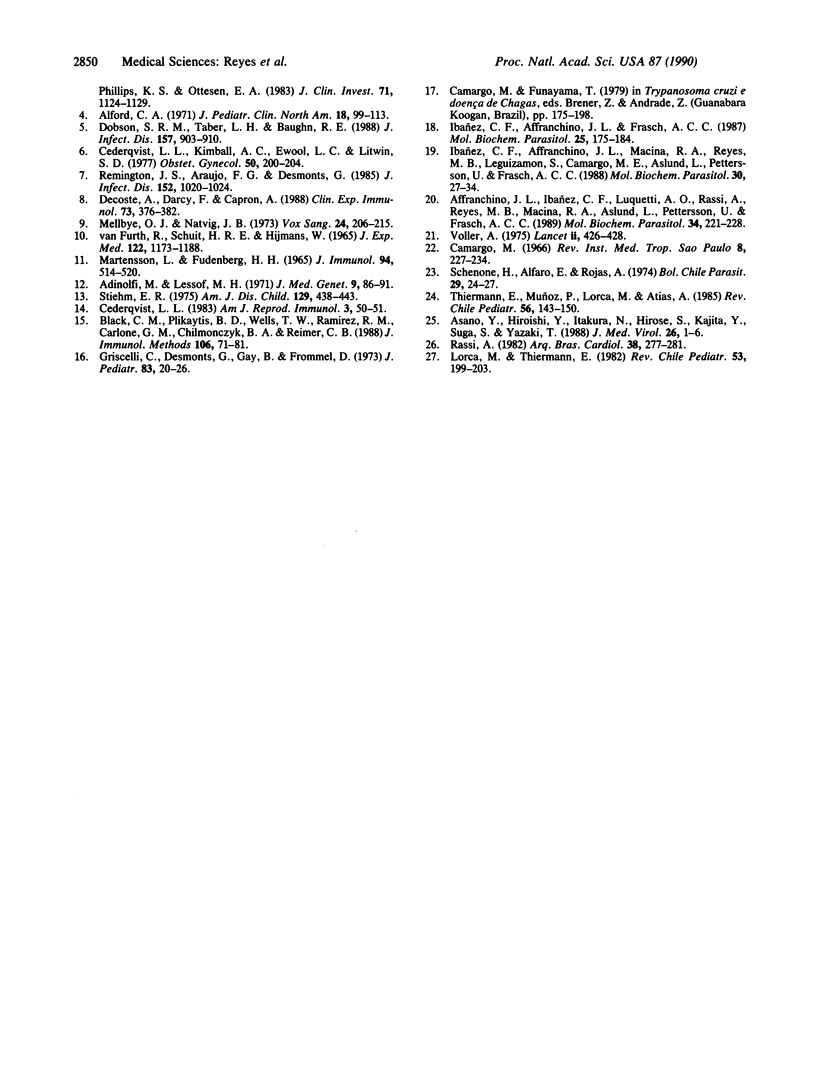
Images in this article
Selected References
These references are in PubMed. This may not be the complete list of references from this article.
- Adinolfi M., Lessof M. H. Development of humoral and cellular immunity in man. J Med Genet. 1972 Mar;9(1):86–91. doi: 10.1136/jmg.9.1.86. [DOI] [PMC free article] [PubMed] [Google Scholar]
- Affranchino J. L., Ibañez C. F., Luquetti A. O., Rassi A., Reyes M. B., Macina R. A., Aslund L., Pettersson U., Frasch A. C. Identification of a Trypanosoma cruzi antigen that is shed during the acute phase of Chagas' disease. Mol Biochem Parasitol. 1989 May 15;34(3):221–228. doi: 10.1016/0166-6851(89)90050-9. [DOI] [PubMed] [Google Scholar]
- Asano Y., Hiroishi Y., Itakura N., Hirose S., Kajita Y., Suga S., Yazaki T. Placental transfer of IgG subclass-specific antibodies to varicella-zoster virus. J Med Virol. 1988 Sep;26(1):1–6. doi: 10.1002/jmv.1890260102. [DOI] [PubMed] [Google Scholar]
- Black C. M., Plikaytis B. D., Wells T. W., Ramirez R. M., Carlone G. M., Chilmonczyk B. A., Reimer C. B. Two-site immunoenzymometric assays for serum IgG subclass infant/maternal ratios at full-term. J Immunol Methods. 1988 Jan 21;106(1):71–81. doi: 10.1016/0022-1759(88)90273-6. [DOI] [PubMed] [Google Scholar]
- Camargo M. E. Fluorescent antibody test for the serodiagnosis of American trypanosomiasis. Technical modification employing preserved culture forms of Trypanosoma cruzi in a slide test. Rev Inst Med Trop Sao Paulo. 1966 Sep-Oct;8(5):227–235. [PubMed] [Google Scholar]
- Cederqvist L. L. Developmental immunology. Am J Reprod Immunol. 1983 Jan-Feb;3(1):50–51. doi: 10.1111/j.1600-0897.1983.tb00213.x. [DOI] [PubMed] [Google Scholar]
- Cederqvist L. L., Kimball A. C., Ewool L. C., Litwin S. D. Fetal immune response following congenital toxoplasmosis. Obstet Gynecol. 1977 Aug;50(2):200–204. [PubMed] [Google Scholar]
- Decoster A., Darcy F., Capron A. Recognition of Toxoplasma gondii excreted and secreted antigens by human sera from acquired and congenital toxoplasmosis: identification of markers of acute and chronic infection. Clin Exp Immunol. 1988 Sep;73(3):376–382. [PMC free article] [PubMed] [Google Scholar]
- Dobson S. R., Taber L. H., Baughn R. E. Recognition of Treponema pallidum antigens by IgM and IgG antibodies in congenitally infected newborns and their mothers. J Infect Dis. 1988 May;157(5):903–910. doi: 10.1093/infdis/157.5.903. [DOI] [PubMed] [Google Scholar]
- FUDENBERG H. H. GM GENES AND GAMMA-G-GLOBULIN SYNTHESIS IN THE HUMAN FETUS. J Immunol. 1965 Apr;94:514–520. [PubMed] [Google Scholar]
- Griscelli C., Desmonts G., Gny B., Frommel D. Congenital toxoplasmosis. Fetal synthesis of oligoclonal immunoglobulin G in intrauterine infection. J Pediatr. 1973 Jul;83(1):20–26. doi: 10.1016/s0022-3476(73)80306-3. [DOI] [PubMed] [Google Scholar]
- Ibañez C. F., Affranchino J. L., Frasch A. C. Antigenic determinants of Trypanosoma cruzi defined by cloning of parasite DNA. Mol Biochem Parasitol. 1987 Sep;25(2):175–184. doi: 10.1016/0166-6851(87)90006-5. [DOI] [PubMed] [Google Scholar]
- Ibañez C. F., Affranchino J. L., Macina R. A., Reyes M. B., Leguizamon S., Camargo M. E., Aslund L., Pettersson U., Frasch A. C. Multiple Trypanosoma cruzi antigens containing tandemly repeated amino acid sequence motifs. Mol Biochem Parasitol. 1988 Jul;30(1):27–33. doi: 10.1016/0166-6851(88)90129-6. [DOI] [PubMed] [Google Scholar]
- Madani G., Heiner D. C. Antibody transmission from mother to fetus. Curr Opin Immunol. 1989 Aug;1(6):1157–1164. doi: 10.1016/0952-7915(89)90009-5. [DOI] [PubMed] [Google Scholar]
- Mellbye O. J., Natvig J. B. Presence and origin of human IgG subclass proteins in newborns. Vox Sang. 1973 Mar;24(3):206–215. doi: 10.1111/j.1423-0410.1973.tb02632.x. [DOI] [PubMed] [Google Scholar]
- Rassi A. Tratamento etiológico da doença de Chagas. Arq Bras Cardiol. 1982 Apr;38(4):277–281. [PubMed] [Google Scholar]
- Remington J. S., Araujo F. G., Desmonts G. Recognition of different Toxoplasma antigens by IgM and IgG antibodies in mothers and their congenitally infected newborns. J Infect Dis. 1985 Nov;152(5):1020–1024. doi: 10.1093/infdis/152.5.1020. [DOI] [PubMed] [Google Scholar]
- Schenone H., Alfaro E., Rojas A. Bases y rendimiento del xenodiagnóstico en la infección chagásica humana. Bol Chil Parasitol. 1974 Jan-Mar;29(1-2):24–26. [PubMed] [Google Scholar]
- Stiehm E. R. Fetal defense mechanisms. Am J Dis Child. 1975 Apr;129(4):438–443. doi: 10.1001/archpedi.1975.02120410026011. [DOI] [PubMed] [Google Scholar]
- Thiermann E., Muñoz P., Lorca M., Atías A. El estudio de las infecciones congénitas por Toxoplasma gondii y Trypanosoma cruzi. Rev Chil Pediatr. 1985 May-Jun;56(3):143–150. [PubMed] [Google Scholar]
- Voller A., Draper C., Bidwell D. E., Bartlett A. Microplate enzyme-linked immunosorbent assay for chagas' disease. Lancet. 1975 Feb 22;1(7904):426–428. doi: 10.1016/s0140-6736(75)91492-0. [DOI] [PubMed] [Google Scholar]
- Weil G. J., Hussain R., Kumaraswami V., Tripathy S. P., Phillips K. S., Ottesen E. A. Prenatal allergic sensitization to helminth antigens in offspring of parasite-infected mothers. J Clin Invest. 1983 May;71(5):1124–1129. doi: 10.1172/JCI110862. [DOI] [PMC free article] [PubMed] [Google Scholar]
- Whitelaw A., Parkin J. Development of immunity. Br Med Bull. 1988 Oct;44(4):1037–1051. doi: 10.1093/oxfordjournals.bmb.a072288. [DOI] [PubMed] [Google Scholar]
- van Furth R., Schuit H. R., Hijmans W. The immunological development of the human fetus. J Exp Med. 1965 Dec 1;122(6):1173–1188. doi: 10.1084/jem.122.6.1173. [DOI] [PMC free article] [PubMed] [Google Scholar]



